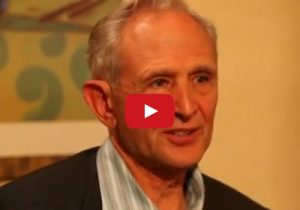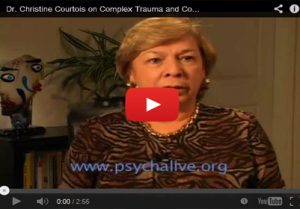VIDEO: Dr. Peter Levine on Working Through a Personal Traumatic Experience
Watch an excerpt from PsychAlive’s exclusive interview with Dr. Peter A. Levine.
Dr. Peter Levine describes working his way through a personal traumatic experience.
Dr. Peter A. Levine: It was a perfect February winter day in southern California. I was going to go up to LA for a friend’s 60th birthday, and as I was crossing the street. A teenage driver — there was a truck at the stop sign — and there was a teenage driver, she didn’t see me because of the truck and she went right through the stop sign and she hit me at about 25 miles per hour.
And I was thrown into the air, thrown first into her windshield, her windshield spider-shattered. And I was thrown back into the street and I was, of course, completely dazed. I didn’t know what was happening. I couldn’t collect my thoughts. I couldn’t understand what was happening. Then I saw her run out of the car, open the car door and I saw the terror on her face, and I realized that I had been hit by her car and, of course, I had no idea how seriously injured I was, no idea.
And an off-duty paramedic came and he announced himself, “I’m a paramedic,” and I turned my head to orient toward where the voice was coming from, and as soon as I started to move, he yelled, “Stop! Don’t move your head. Your neck could be broken.” Yeah, and so I went back into a deeper shock. And I went in so deeply that I left my body, which is an experience that traumatized people have, and it was as though I floated above my body and I was looking down at this whole event, seeing my crumpled body laying there and seeing him commanding me what to do. And then he started firing questions at me. You know, what was my name? where was I going? what is today’s date? And I said, “Please, just leave me alone. I’ll answer your questions later.”
And in being able to do that, I felt a little bit less helpless. Then he took my pulse and a little time later, a woman came by, and she said, “I’m a doctor, a pediatrician, actually. Is there anything I can do?” And I said, “Please, sit by me.” And she did and she grasped my hand. And I could feel her hand and I could smell the scent of her perfume, and the soothingness of her voice. And all of that gave me the feeling that, “I’m not alone,” and by having that feeling, I was able to go into my body, into my body, and feel where the shock was locked in my body. And then I was gradually able to let the shock move through, listening to my body in its unspoken voice, and I experienced waves of shaking and trembling.
I felt my left hand wanting to go up as it had done to prevent my head from hitting on the car, the windshield, and then after a little while, a little more shaking, trembling, more waves of heat, waves of rage, red rage, and the words, “How could that idiot, how could she go through a stop sign!” I mean, always with trauma, you always have to have somebody to blame … and then feeling my hand come out to protect myself from hitting my head against the road, Highway 1.
And then the ambulance came, and the woman was very nice; she let me use her cell phone to call somebody to meet me at the hospital and I had asked if we could go to the local hospital. There was a hospital a mile or two away. She said “No, no, no. We have to go to a major trauma center because you very likely have internal bleeding, internal injury.” So I said, “Well …” And she took my pulse and my heart rate. She took it again and I said, “Can you tell me what the pulse, what it is, my vital signs?” and she said, “No, I can only tell that to the doctor.”
And I said, “Well, actually I am a doctor,” — half-truth, right, I mean I’m a doctor of one kind. And she said, “Well, I have to check again.” She said, “Something must be wrong.” I said, “What do you mean?” She said. “Well, your heart rate is 74, your pulse, your blood pressure is 120 over 70,” she said. “But when I talked to the paramedic, your heart rate was about 160! I don’t understand.”
And so then, of course, I never miss an opportunity to teach. And so I explained to her what I was doing and she said, “You know, a few weeks ago, we had a course in critical incident debriefing, where we all had to talk about the horrible things we had experienced and I felt so much worse after it, but it seems like you didn’t do anything like that at all. Would you be willing to come and teach us a class?” and I said, “Sure”, and I gave her my contact information. I was greatly relieved that my method worked, for sure.
But there was another thing that was important. It’s nothing that we…nobody can do it for us, but we can’t do it alone. I mean, even with 40 years of developing the methodology and working, literally, with thousands of clients, I don’t think I could have done what I did, certainly not as effectively, had that pediatrician, had that woman not come there and sat there with her warmth, with her presence. And actually, this conference tomorrow, it’s really a lot about the presence that the analyst, the therapist, brings to bear as a critical component, maybe even thecritical component in what happens in the person’s healing. So, you know, there’s a Motown song, it goes something like, “It takes one to stand in the dark alone, it takes two to let the light shine through.”
A number of my students have taken this work and developed it in ways that people use it in their own communities so that when there’s a disaster, they are empowered to help each other, because there’s not that kind of mental health capacity and most of the mental health capacity doesn’t even understand how to do this, work like this.
So by empowering people to help each other, I think we have another tremendously important application of this body of knowledge and this way of attending to and working with the organism and helping people contact that unspoken voice—the voice without words that voices that which is so profoundly wise and timeless and which will guide us back toward wholeness.
Tags: expert interview, post-traumatic growth, trauma, video, videos








Leave a Reply